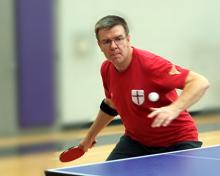During the last 18 years, I have practiced at many table tennis training centers in the US, Canada, Europe, and Asia. In recent years, I have recognized four modern changes at the elite level.
Blocking with More Variation
In the past, one player would consistently block in a set pattern and the attacking player would attempt to loop 10-20 balls in a rally. Now, the blockers have added more variation – sometimes harder, sometimes softer, sometimes flat, sometimes with a little topspin.
Multi-Location Blocking
In the past, one player might loop to the blockers backhand, while the attacking player performed a footwork drill. Now, the attackers have added an additional location. For example, the attacker might hit 1 ball to the backhand and 1 ball to the middle, while the blocker hits random to the attacker’s ¾ forehand side of the table.
Mixing Offense and Defense
In the past, one player might attack for 10 minutes while the other player blocked. After 10 minutes, the players would reverse rolls. Now, many of the drills include both players attacking and defending. One player might perform 1 round of the faulkenberg drill (1 backhand, 1 forehand from the backhand side, and 1 forehand from the forehand side) while the other player blocks. After the first 3 balls, the blocker turns into the attacker.
Opened-Ended Drills
In the past, one player might attack for 10 minutes in a continual pattern until he missed. Now, many of the drills start in a pattern and end like a game. For example, the attacking player might play 2 backhands, 2 forehands, 2 backhands, 2 forehands, then the rally becomes open to both players. From this point on, either player can attack or defend and either player can hit anywhere on the table.
Asian and European Training Centers

Learn about 4 recent changes!
Category:



